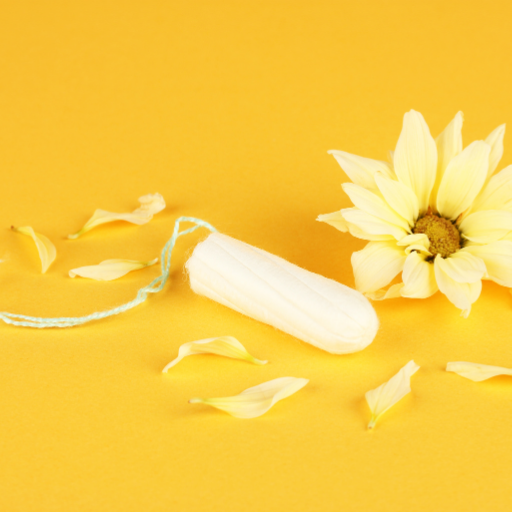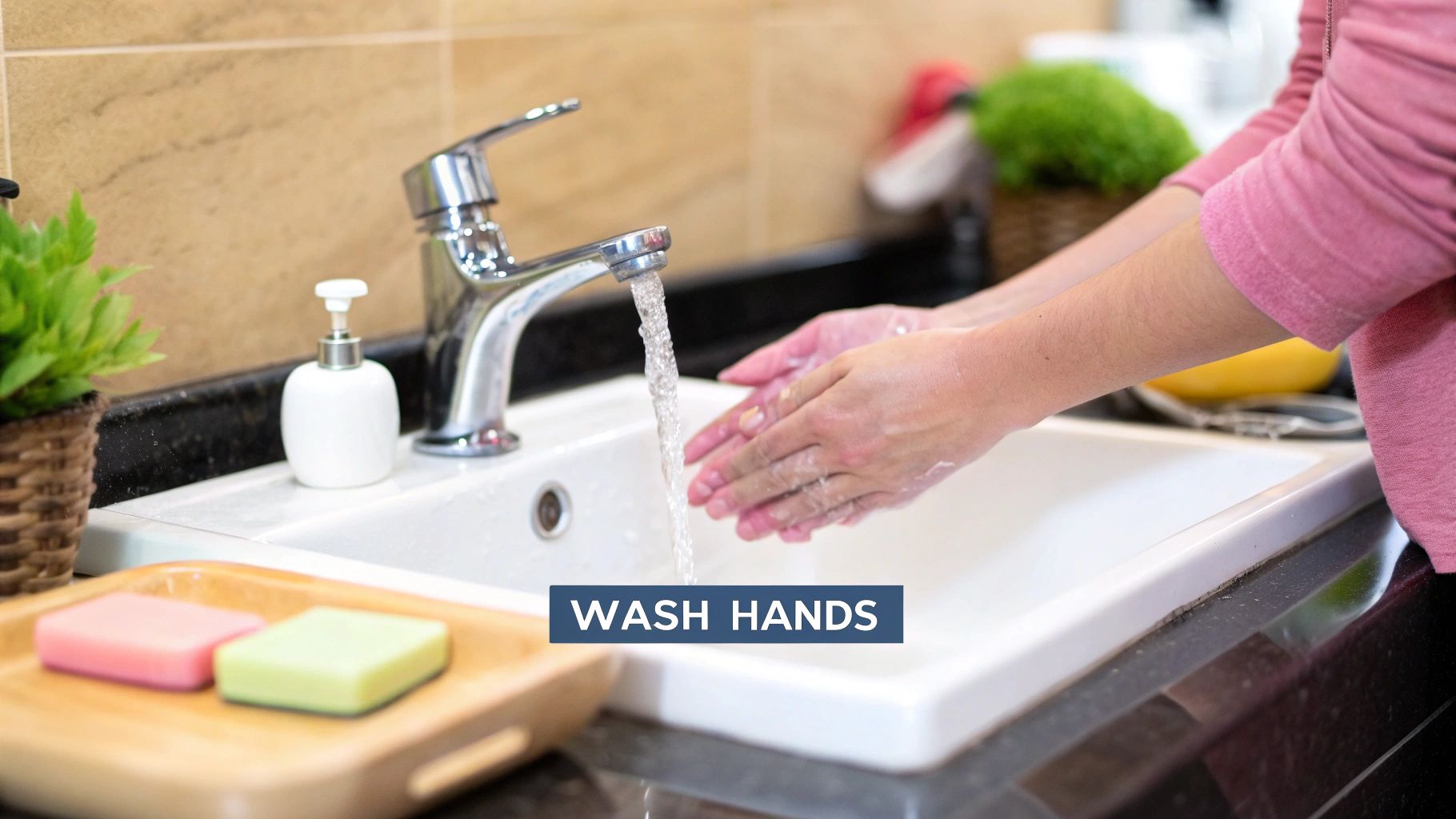
How Do You Stick a Tampon In? Easy Step-by-Step Guide
Share
Figuring out how to use a tampon can feel a bit weird at first, but honestly, it’s a pretty simple process once you get the hang of it. The biggest secret? Relax your muscles. Once you’re in a comfortable position, you just gently guide the tampon upwards and slightly towards your lower back. When it’s in the right spot, you shouldn't feel it at all.
Your Guide to Using Tampons for the First Time

Feeling a bit nervous about trying a tampon? That’s totally normal, and we promise you're not alone. Let’s just treat this as a friendly chat to help you feel more confident before you even open the box. Getting to know your body and your period products is the best way to have a stress-free experience.
A tampon is a small, absorbent cylinder, usually made from soft materials like organic cotton. It's designed to sit inside your vagina and absorb your menstrual fluid before it leaves your body. The vaginal canal is a muscular tube that's surprisingly flexible, so a tampon can sit comfortably inside without you even noticing it's there.
Understanding Tampon Types and Absorbency
Here in New Zealand, you’ll mostly find digital tampons. That just means you use your finger to insert them instead of a plastic or cardboard applicator. This digital method actually gives you more direct control over placement and angle, which many people prefer once they get the hang of it. Picking the right absorbency is also a huge part of staying comfortable and leak-free.
- Light/Mini: Perfect for those first or last few days when your flow is super light.
- Regular: This is your go-to for most days of your period. It’s a great place to start.
- Super/Super Plus: Save these for your heaviest flow days when you need that extra bit of protection.
Here's a pro tip: always use the lowest absorbency you need for your flow. It’s not just about comfort; it also helps reduce the risk of Toxic Shock Syndrome (TSS), which is a rare but serious bacterial infection.
Getting your first period can feel like a lot to take in. If you’re just starting out on your menstrual journey, our complete first period guide has heaps of friendly advice and support. The goal is to feel empowered and clued-up, so you can turn any of that first-time anxiety into pure confidence.
A Practical Walkthrough: How To Insert A Tampon
Alright, let’s get down to the practical side of things. The single most important part of this whole process is to take a deep breath and relax. Seriously. When your muscles are tense, everything becomes more difficult and uncomfortable. The goal is to make this feel natural, not like some rigid medical procedure.
First up, hygiene is non-negotiable. Always start by washing your hands thoroughly with soap and warm water. This is crucial to prevent introducing any unwanted bacteria. Once your hands are clean and dry, you can unwrap your digital tampon. Look for the coloured tear strip to get the wrapper off easily, then give the string a gentle tug to make sure it’s properly secured.
Finding Your Position And The Right Angle
Now it's time to get comfortable. You need to find a position that helps open up your pelvic area, and there’s no single “right” way to do this—it’s all about what feels best for your body.
- Sitting on the loo: This is a classic for a reason. Just sit down and let your knees fall apart naturally.
- Standing with one leg up: Propping one foot on the edge of the bath or the toilet lid can really help open things up and create a better angle for insertion.
- A slight squat: Squatting down a little can also help relax and open those pelvic floor muscles, making everything a bit easier.
Once you’re in a relaxed position, hold the tampon at the base, right where the string comes out. The real trick to comfortable insertion is getting the angle right. Your vaginal canal doesn’t go straight up; it actually slopes slightly toward your lower back. So, you want to aim the tampon in that direction, not vertically upwards.
The image below gives a great visual of how this works.
As you can see, a calm approach and the correct positioning are what make all the difference.
With a digital tampon, your finger is the guide. Gently push the tampon into your vaginal opening with your index finger. Keep pushing it in slowly and steadily until your finger makes contact with your body. That’s your signal that the tampon is deep enough inside. It needs to sit in the middle part of your vagina, a spot with far fewer nerve endings, which is why you won’t feel it when it’s in the right place.
Here’s the golden rule: If a tampon is inserted correctly, you genuinely shouldn't be able to feel it at all. If it feels uncomfortable, or you feel a poking sensation, it’s probably not in far enough. Don’t be afraid to take it out and try again with a fresh one. It can take a few attempts to get the hang of it, and that’s perfectly okay.
Quick Guide To Comfortable Insertion Positions
Finding the right stance can make a huge difference. Here’s a quick breakdown of common positions and why they work, helping you find your go-to method.
| Position | Technique Tip | Best For |
|---|---|---|
| Sitting on the Toilet | Lean forward slightly to relax your pelvic floor muscles. | Beginners, as it's a stable and natural position. |
| Standing with Leg Up | Place one foot on the toilet seat or side of the bath. | Creating an open angle that simplifies insertion. |
| Squatting | Keep your feet flat and lower into a slight squat. | People who are comfortable with their body and want maximum pelvic opening. |
Ultimately, the best position is the one where you feel most relaxed. Experiment a little to see what works best for you—soon enough, it will become second nature.
How to Know Your Tampon Is In Correctly
Alright, you've done it! The tampon is in. But now you're probably wondering, "Is this right?" The biggest clue is simply how you feel. A correctly inserted tampon should be completely unnoticeable. Seriously, you shouldn't feel it at all.
This magic happens because the tampon sits in the middle part of your vagina, a spot with very few nerve endings. It's a bit like a contact lens—once it’s settled in the right place, you forget it’s even there.
On the other hand, if you feel a poking sensation or a sense of pressure when you sit, walk, or bend over, that’s a sure sign it’s not quite in the right spot. This usually means it's sitting too low, closer to the vaginal opening where the nerves are far more sensitive.
Troubleshooting and Making Adjustments
Don't stress if this happens! It’s super common, especially when you're just getting the hang of it, and it's an easy fix. If a tampon feels uncomfortable, the best move is to take it out and start over with a fresh one. Sometimes a small adjustment is all it takes to go from annoying to unnoticeable.
The only thing you should be aware of is the removal string. It needs to be hanging comfortably outside your body, easy to find when it's time to take the tampon out.
Think of this process as getting to know your body better. Each time you insert a tampon, you learn a little more about your own anatomy and what feels right for you. This kind of self-awareness is a huge part of managing your period with confidence.
Here’s a quick checklist to know if you've got it right:
- You feel absolutely nothing: This is the goal! Perfect placement.
- You feel a poking or pressure: It's sitting too low. Take it out and try again, aiming a bit deeper and angling it slightly toward your lower back.
- The string is hanging outside: Exactly what you want. This makes removal simple and stress-free.
Once you’ve nailed the placement, you can get back to your day without giving it a second thought. No leaks, no discomfort—just total security.
Tackling Common Tampon Worries
It’s totally normal to have a few questions and "what ifs" when you're getting the hang of tampons. Let's walk through some of the most common concerns so you can feel completely at ease.
One of the biggest anxieties is often: "Can a tampon get lost inside me?" Let me put your mind at rest right away—the answer is a definite no. Your vagina is a muscular canal that’s closed off at the top by your cervix. The opening of the cervix is tiny (we're talking pinhead-sized when you're not in labour), so there's simply nowhere for a tampon to go. It will stay put right where you left it until it’s time for a change.
What You Need to Know About Toxic Shock Syndrome
Toxic Shock Syndrome, or TSS, is another topic that can cause some worry. While it sounds intimidating, TSS is an incredibly rare bacterial infection caused by Staphylococcus aureus or Streptococcus pyogenes bacteria releasing toxins into the bloodstream. The key is knowing how to use tampons safely to keep your risk as low as possible.
The golden rule is to change your tampon regularly, which means at least every 4 to 8 hours.
It’s also a great habit to use the lowest absorbency that matches your flow. This isn't just more comfortable; it encourages you to change it on schedule. For a deeper dive, we've broken down everything you need to know about Toxic Shock Syndrome and your period products on our blog.
What if It’s Painful or Hard to Insert?
If you're struggling to get a tampon in, the first thing to remember is: don't force it. Pain is your body's signal that something isn't quite right. Common troubles during menstruation like vaginal dryness or conditions like vaginismus can make insertion difficult, but usually, it's a simple fix.
Here are a few things that usually solve the problem:
- Relax Your Muscles: It's a natural reaction to tense up, but this is the number one reason insertion can be tricky. Take a few deep breaths and consciously try to relax your pelvic floor muscles.
- Switch Up Your Position: Sometimes, a simple change of scenery helps. If sitting on the toilet isn’t working, try standing up and propping one leg on the side of the bath.
- Check the Absorbency: Trying to insert a super tampon on a really light day can be difficult due to a lack of natural lubrication. Make sure you're matching the tampon to your flow—a lighter absorbency might just slide in much more easily.
Period Products and Equity in New Zealand
The way we talk about and manage periods is definitely changing, and that conversation is happening right here in Aotearoa. For decades, tampons have been a go-to, but we're starting to see a real shift in how people, especially younger Kiwis, approach their period care. This isn't happening for just one reason; it's a mix of everything from personal comfort to a growing focus on sustainability and body literacy.
This evolving landscape shows that choosing a product isn't just about what works best for your flow. For many, it's also about convenience, cost, and what feels right for their values. Digital (non-applicator) tampons, like those we sell at Crimson Organic, remain a popular choice due to their minimal waste and the direct control they offer during insertion.
The Bigger Picture in Aotearoa
But the conversation goes much deeper than just personal preference. For some, the choice of a period product is completely dictated by cost, shining a light on period equity—a significant issue in our communities. Access to period products isn't a given for everyone, which creates a very real barrier to comfort, health, and dignity.
A 2019 survey brought this home, revealing that 12% of New Zealand students between Year 9 and Year 13 had trouble getting period products because of the cost. In one small focus group, it was found that only one out of six teenagers regularly used tampons, with most opting for alternatives they simply found more comfortable or affordable.
This issue of "period poverty" means that for many young people, the question isn't "which product do I prefer?" but "which product can I afford?" This reality shapes how people learn to manage their periods from the very start.
Making sure everyone has access to the products they need is fundamental to achieving equity. Thankfully, initiatives providing free period products in NZ are a massive step in the right direction. They help to close this gap and ensure no one has to miss out on school, work, or daily life simply because they have their period. Addressing this is key to creating a more supportive environment for everyone who menstruates.
Still Got Questions? Let's Talk Tampons
Even once you've got the hang of using tampons, a few questions might still pop into your head. That's completely normal. We've gathered some of the most common queries we hear to give you clear, straightforward answers and help you feel confident no matter what.
How Long Can a Tampon Stay In?
The golden rule is to change your tampon every 4 to 8 hours. It's crucial not to leave it in for longer than 8 hours. This simple habit dramatically reduces the already very small risk of an infection called Toxic Shock Syndrome (TSS).
A great tip from experience? Always use the lowest absorbency that can handle your flow on any given day.
Can You Go Swimming With a Tampon?
Yes, you absolutely can! This is one of the best things about tampons. They're worn internally, so they catch your period flow before it even has a chance to leave your body.
This makes them a super discreet and reliable choice for a day at the beach or a swim at the pool. Just make it a habit to pop in a fresh one soon after you've finished your swim.
What if the String Disappears?
Okay, first things first: don't panic. While it’s incredibly rare for a tampon string to go missing, it can happen. If you can’t immediately find it, the first step is to wash your hands thoroughly.
Next, find a comfortable position, like a deep squat. Take a few deep breaths to relax your pelvic floor muscles.
Gently bearing down, similar to the motion of having a bowel movement, can help push the tampon lower. Usually, this is all it takes to bring it within reach of your fingers. If you've tried and still can't retrieve it, it's time to get a little help. Just give your doctor or a local sexual health clinic a call.
At Crimson Organic, we're all about making period care simple, safe, and kind to the planet. Our GOTS-certified organic cotton tampons are designed with your comfort and peace of mind at their core. Feel the difference and manage your period with total confidence by checking out our range at https://crimsonorganic.co.nz.
